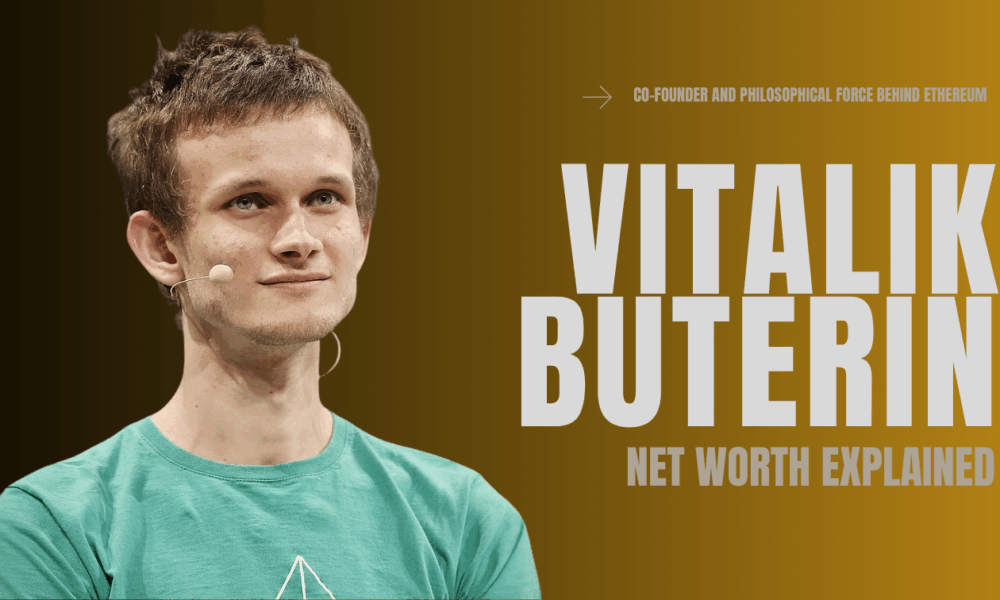Vitalik Buterin Net Worth Explained

In 2025, few names in the cryptocurrency world carry as much weight as Vitalik Buterin, the co-founder and philosophical force behind Ethereum, the world’s most influential smart contract platform. A decade after Ethereum’s launch, Buterin remains not only a symbol of blockchain innovation but also a rare example of a billionaire seemingly indifferent to wealth itself.
As Ethereum continues to power DeFi, NFTs, and Layer-2 networks, public curiosity about Buterin’s net worth has reignited. How much is he truly worth today—and what does wealth even mean to someone who helped redefine the digital economy?
Who Is Vitalik Buterin?
Born in 1994 in Kolomna, Russia, and raised in Canada, Vitalik Buterin was drawn to mathematics and programming from an early age. His father introduced him to Bitcoin in 2011, sparking a fascination that would soon evolve into a lifelong pursuit.
Before co-founding Ethereum, Buterin launched Bitcoin Magazine, one of the earliest and most respected crypto publications. It was through writing about Bitcoin’s limitations that he developed a bold idea: what if blockchain could go beyond currency to become a global computational platform?
Even early on, Buterin stood out for his mix of intellect and idealism. Rather than chasing corporate success, he approached blockchain as a social experiment in fairness, transparency, and open collaboration — values that would come to define Ethereum’s culture.
From Idea to Ethereum
By 2013, Buterin had become a prominent thinker within the Bitcoin community, but he was frustrated by Bitcoin’s limited scripting capabilities. In late 2013, he authored the Ethereum Whitepaper, outlining a blockchain designed to run decentralized applications through smart contracts.
In 2014, Buterin and a small group of collaborators turned that vision into reality. Ethereum officially launched in July 2015, transforming blockchain from a financial technology into a programmable infrastructure.
Buterin’s creation reshaped the digital landscape. Ethereum became a foundation for new financial models, decentralized governance, and even cultural movements like NFTs — all built on the open principles he championed.
Ethereum’s Rise and Buterin’s Growing Wealth
After its 2015 debut, Ethereum’s growth was rapid and relentless. Developers adopted it to build decentralized apps (dApps), while major companies explored smart contracts to automate trust. The 2017 ICO boom, followed by the DeFiand NFT waves of the early 2020s, propelled Ethereum into the global spotlight — and with it, Vitalik Buterin’s wealth.
By 2021, when ETH hit an all-time high of around $4,800, Buterin briefly became a billionaire in his twenties. This milestone was a key moment in the journey toward the ambitious Ethereum and Bitcoin value predictions that see each hitting new ATHs by 2025. Yet his net worth has always reflected Ethereum’s volatility. Bear markets in 2022 and 2023 reduced those paper gains, but by 2025, with Ethereum stabilizing above $3,500 and widespread Layer-2 adoption, his fortune remains substantial and tightly linked to the network’s success.
Unlike many founders, Buterin never diversified heavily into private companies or venture funds. His wealth remains unusually transparent — visible on-chain, traceable, and often discussed in public forums.
CoinGecko — Ethereum (ETH) price & market snapshot (October 16, 2025).
Vitalik Buterin’s Net Worth and Holdings in 2025
Most estimates place Buterin’s wealth primarily in Ethereum (ETH), spread across a small number of publicly known wallets. According to CoinMarketCap, Ethereum remains the second-largest cryptocurrency by market capitalization, giving context to the scale of his holdings.
Ethereum key network and market metrics (updated 2025).
Analysts suggest he controls several hundred thousand ETH across different addresses — a fortune that fluctuates daily with market conditions. Small moves in ETH’s price can shift his paper wealth by hundreds of millions, underscoring the fluid nature of crypto-based net worth.
Buterin’s greatest innovation, however, goes far beyond personal fortune. He helped design the technology that enables seamless value exchange between blockchains — the very foundation that allows users today to swap ETH for virtually any other crypto asset. For example, the easiest way to convert ETH to Solana illustrates how Ethereum’s infrastructure continues to empower real-world utility across the digital economy.
Buterin also participates modestly in DeFi protocols, staking, and governance experiments, though these positions appear to serve more as ecosystem support than investment. Any private or off-chain assets remain undisclosed, but on-chain transparency has long been part of his philosophy: a belief that even personal wealth should reflect the openness of the systems he helped build.
Net Worth Evolution (2015–2025)
When Ethereum launched in 2015, ETH traded for less than a dollar, and Buterin’s initial allocation — roughly 0.7% of the total supply — was worth only a few hundred thousand dollars.
The 2017 bull run pushed his net worth into the hundreds of millions as ETH passed $1,000. Four years later, during the 2021 surge, his holdings temporarily exceeded $1 billion. Subsequent downturns cut those valuations in half, but Ethereum’s transition to Proof of Stake and its adoption in institutional portfolios brought renewed stability.
By 2025, with ETH hovering between $3,500 and $4,500, Buterin’s estimated net worth sits between $600 million and $1.2 billion, depending on market swings. More importantly, it remains tied directly to Ethereum’s success, reflecting a rare kind of integrity in an industry where most founders have long since cashed out.
Ethereum’s Total Value Locked (TVL) exceeded $60 billion as of October 2025, according to DefiLlama.
Non-Crypto Assets and Investments
While most of Buterin’s wealth lives on the blockchain, he has quietly supported projects outside crypto that align with his values. He’s backed research into zero-knowledge proofs, AI safety, and digital privacy, often through grants and advisory roles rather than equity stakes.
The Vitalik Buterin Foundation funds academic research and humanitarian technology, reinforcing his belief that innovation should serve humanity first. Compared to his Ethereum holdings, these investments are modest — but philosophically significant. They represent a holistic vision of wealth as a tool for collective progress, not private luxury.
Known for his minimalist lifestyle and low public profile, Buterin channels much of his financial power into enabling others to experiment, discover, and build.
Philanthropy and Public Donations
Buterin’s philanthropic record is as remarkable as his technical one. In 2021, he famously donated over $1 billion in SHIB tokens to India’s COVID-19 relief fund — one of the largest individual crypto donations ever made. The act exemplified his view that wealth, especially in crypto, carries a moral responsibility.
Since then, he’s contributed to causes ranging from pandemic research and longevity studies to AI ethics and public goods funding for Web3 infrastructure. Many of these efforts operate through transparent channels like the Ethereum Foundation or CryptoRelief.
His giving is consistent, not performative: more focused on open-source science and social resilience than headlines. Buterin often describes philanthropy as an “engineering problem” — something that, like code, can be optimized for real-world impact.
Comparison with Other Ethereum Founders and Crypto Billionaires
Among Ethereum’s co-founders, Buterin stands apart for his singular focus on research and public good. While peers like Joseph Lubin (ConsenSys) and Charles Hoskinson (Cardano) built companies and separate blockchains, Buterin stayed rooted in Ethereum’s open-source mission.
His wealth is smaller than that of crypto exchange founders like Changpeng Zhao or Brian Armstrong, but his influence arguably runs deeper. He shapes Ethereum’s roadmap, governance discussions, and the broader ethical tone of the crypto community.
In a field often dominated by hype and profit, Buterin represents a different model: intellectual wealth over material excess, credibility over commercialization. His standing illustrates that influence in crypto isn’t just measured in billions — it’s also measured in principles.
Conclusion
Ten years after Ethereum’s birth, Vitalik Buterin’s net worth remains both dynamic and symbolic. It fluctuates with ETH’s price, but its meaning transcends numbers. His fortune is less a product of speculation and more a reflection of a decade-long commitment to open technology and collective ownership.
While many early crypto figures moved on to corporate empires, Buterin continues to build, donate, and research — all within the decentralized ecosystem he envisioned. His approach challenges traditional ideas of success: wealth not as an end, but as a means to build a freer digital world.
In 2025, as Ethereum anchors global finance, Buterin’s legacy endures not merely in code or coin, but in the culture of openness he helped create — proof that the most valuable currency in crypto may still be trust.





